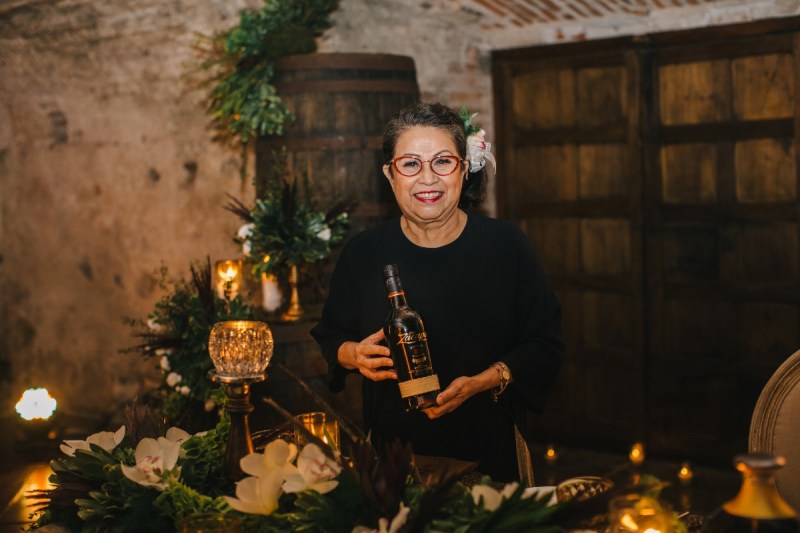Rum, the often brown liquor that tastes of toasted sugar, is wrapped in a bitter history. Rum was a central Caribbean product from the 16th to 19th centuries when the New World slave trade brought Africans to West Indian colonies for molasses, which, in turn, was shipped to New England to produce the liquor, and then exchanged back in Africa for more slaves. Zacapa Rum is taking ownership of that story in present times, empowering the spirit and its producers.
Crafted in Southern Guatemala from sugar cane grown in Southern Guatemala’s mineral-rich volcanic soil, Zacapa No. 23 Rum uses the first press of virgin sugar cane to craft its product, instead of the molasses by-product of sugar manufacture. From the liquid to the bottle, Zacapa’s rums are the result of female, Guatemalan craft artisans — a marked digression from a male-dominated industry.

This is true from the top down at Zacapa, beginning with the delicate care of Master Blender Lorena Vásquez — one of only a few female Master Blenders in the industry — and Master Mixologist Lynnette Marrero — widely regarded as one of the pioneer female cocktail-specific bartenders in the industry. After leaving their hands, each Zacapa bottle is adorned by a petate (woven palm leaf) band, wrapped from the hands of one of over 700 Guatemalan female artisans employed by Zacapa.
Vásquez is Nicaraguan by birth but has lived in Guatemala since the late 1970s. In Nicaragua, she studied pharmaceutical chemistry and food science, before joining ILG in 1984. She has been working directly with Ron Zacapa since 1985.
The Manual exchanged questions with Vásquez to learn more about this emancipated Central American brew. (This interview has been edited for clarity.)
TM: What is your role at Zacapa Rum?
LV: I’m responsible for evaluating and classifying the rums as they arrive from the distillery; researching new technologies, processes, and products across different markets; developing innovations in the production process (for example, the use of different types of wood and barrels during maturation); creating new rum blends; evaluating competitor products; and managing the quality control programs that assist in the maintenance of quality and consistency in the product.
TM: What does a “cocktail-specific bartender” do at Zacapa?
LV: (Design) cocktails that allow you to enjoy Rum Zacapa, such as an Old Fashion, Manhattan, or Zacapa Sour.
TM: What are the primary aromas and flavors Zacapa is going for? How does this differentiate them from other rums?
LV: Zacapa is a rum produced in Guatemala, a unique country with diversity in terms of culture, ethnicity, natural and environmentally; all part of the process of development of Ron Zacapa, where time, patience, and devotion are present in every drop.
The difference starts from the quality of sugarcane grown at home to produce the “virgin honey”, fermentation and distillation that are specific to Ron Zacapa, the aging height “in the house above the clouds” and the Solera system adapted Ron Zacapa.
Guatemalan doctor and chemist Alejandro Burgaleta unveiled the first bottle of Ron Zacapa Centenario in 1976, on the centennial anniversary of the town of Zacapa in eastern Guatemala.
TM: Virgin sugarcane is sweeter than molasses. How does this help Zacapa’s taste profile?
LV: The canes are washed, chopped, shredded, and then milled to extract the juice, which is filtered to remove any particles or impurities. The residue removed during filtration is known as ‘bagasse’ and is used to fire the boilers.
The juice is then clarified and heated to boil off unwanted water to reduce it to honey. The gentle heating process does not remove any sugar, but it does cause some impurities to crystallize out, leaving a pure, ’virgin’ honey with a high natural sugar content of 74%, as against the 30-33% common in blackstrap molasses.
Molasses is a dark, concentrated residue that is left at the end of the sugar refinement process. During the refinement process, a significant amount of the flavor components original to the sugarcane juice are lost. It has a slightly bittersweet taste and a high content of glucose sugars and is used as the raw material for many brands of rum.
The virgin sugarcane honey is quite stable due to its high sugar content and can be stored for several months at the distillery before use. It has a delectable, sweet taste and the same balance of sucrose, glucose, and fructose as sugarcane juice.
TM: How does Zacapa employment impact communities?
LV: Zacapa has a direct impact in different areas, providing jobs to those who do the work in the cane fields, in the sugar mill, in the distillery and aging facility.
One of the most important contributions is that the petate rings are weaved by indigenous women from different communities, who are able to work from home this 100% handcraft ring. This has generated a great social and economic impact on those communities.
TM: How did Zacapa become a female-empowered and led company?
LV: The alcohol business has traditionally been male-dominated and as a result, the industry was more focused on masculine tastes. Naturally this led to more men working in the art of blending. There is no doubt it is a very demanding role and at the time as the industry was developing, women focused on taking care of their children and homes. Therefore, it may not have been an appealing area to work in.
However, times are changing and it’s very exciting to be part of it. Women are adapting their lifestyles and empowering themselves with knowledge and education. I believe it is important to break down these barriers and dismiss stereotypes as we welcome more women into this vibrant and fascinating industry.
TM: How can more women get involved?
LV: The drinks that are growing are those of the highest premium niche, (people) enjoying less quantity but better quality. It is an industry where the participation of women is increasingly relevant in different areas. Women have to have the openness to do it.



